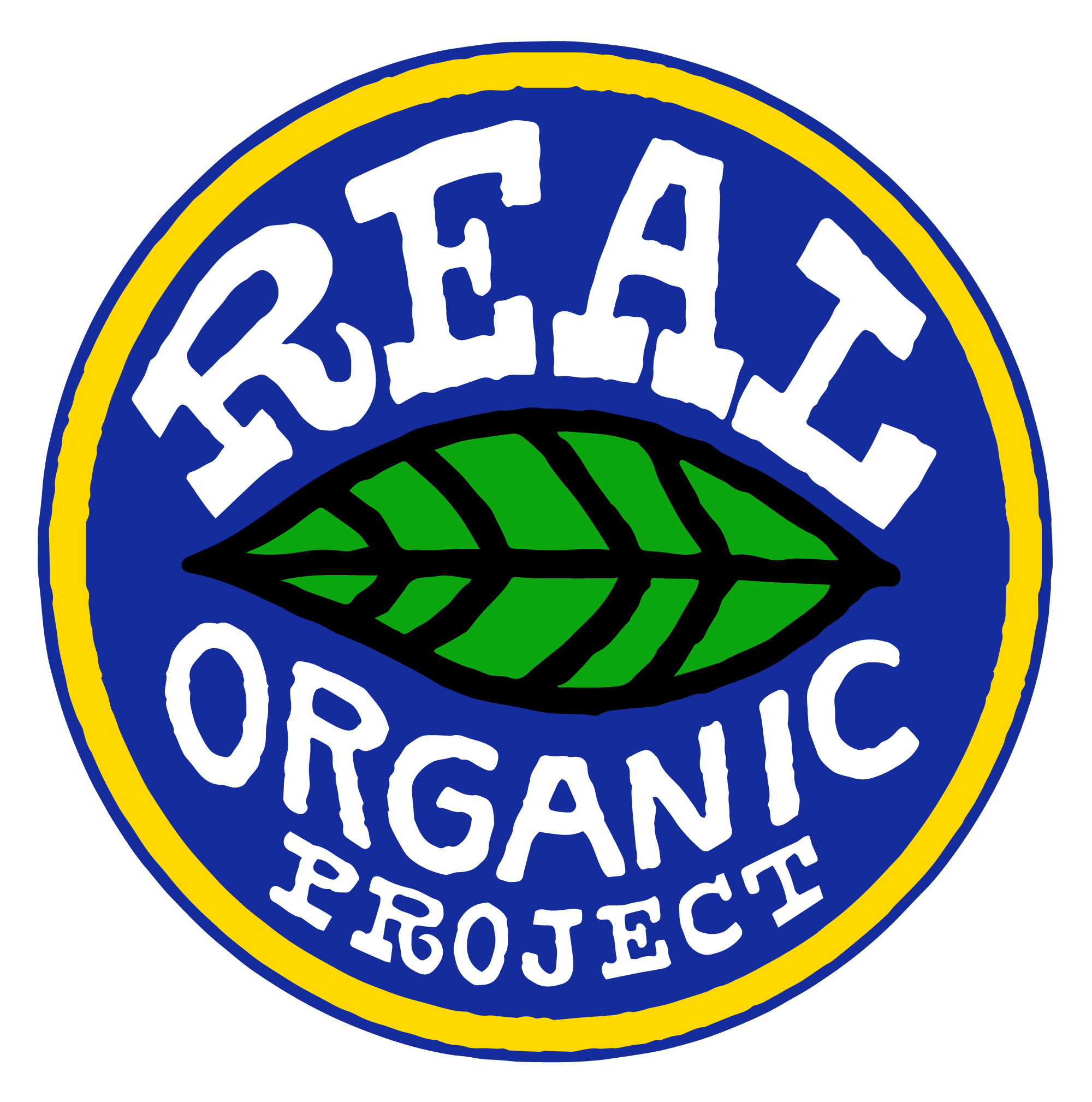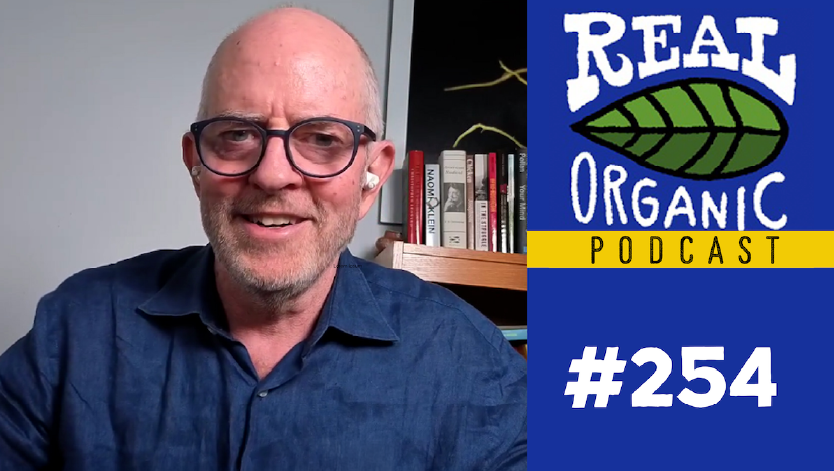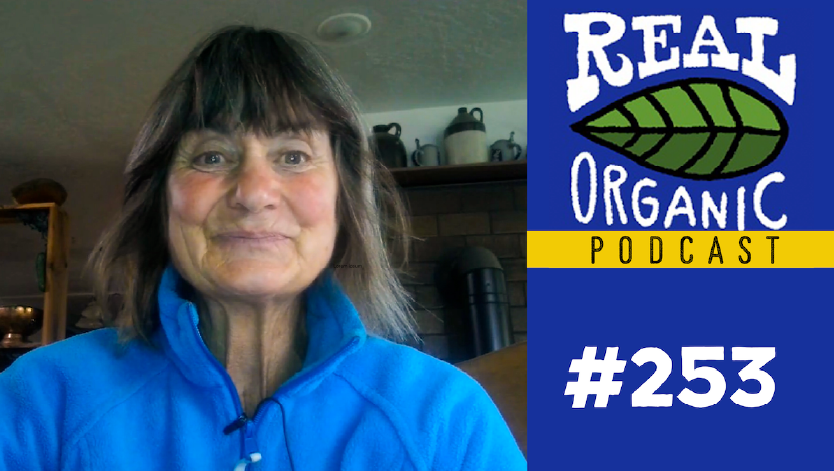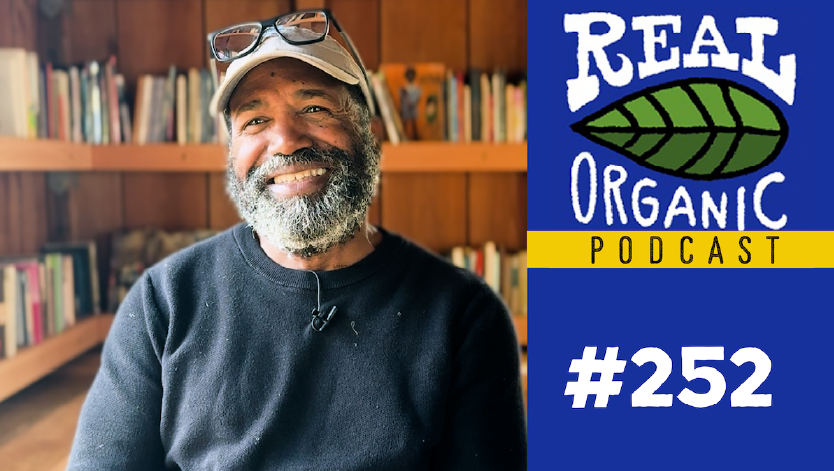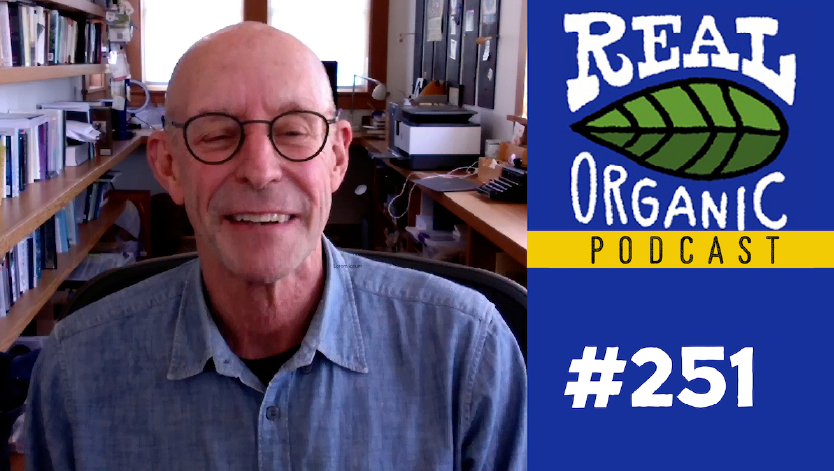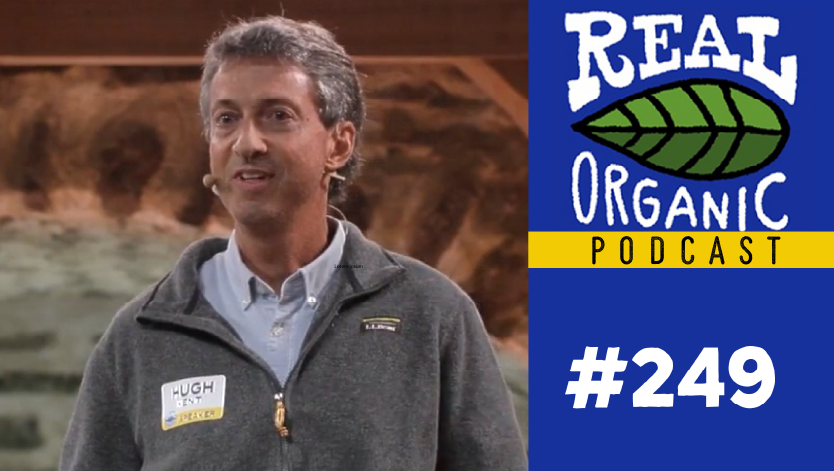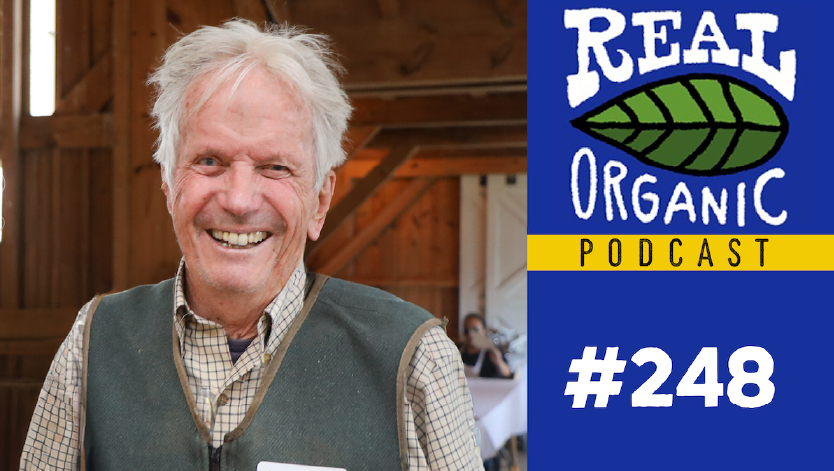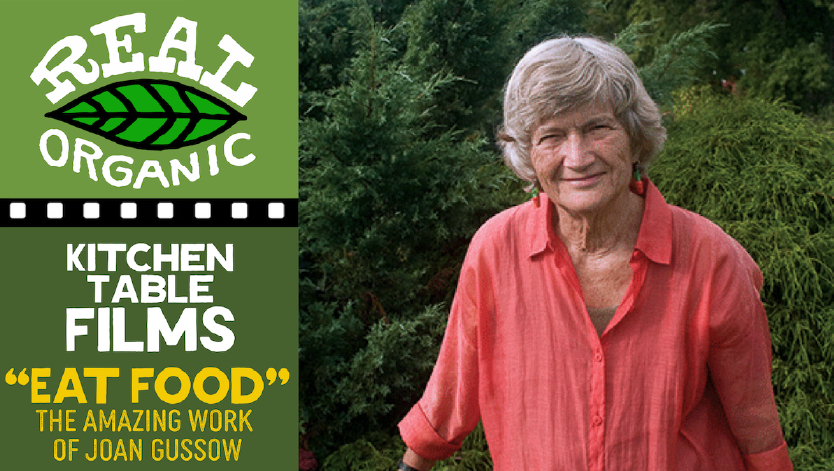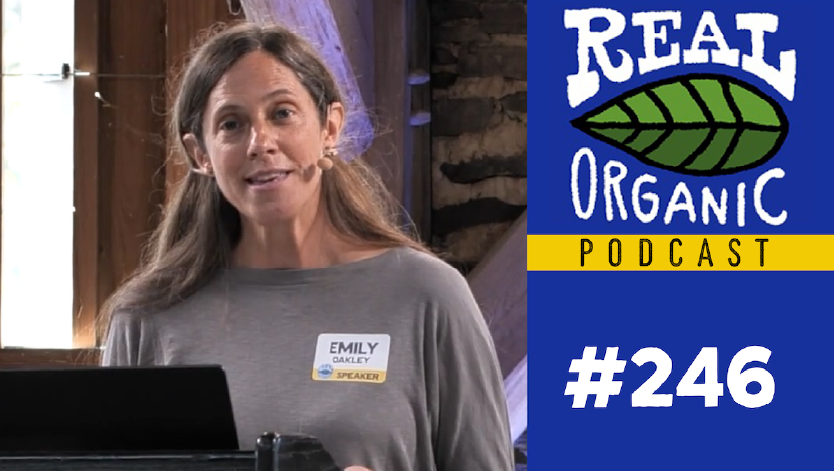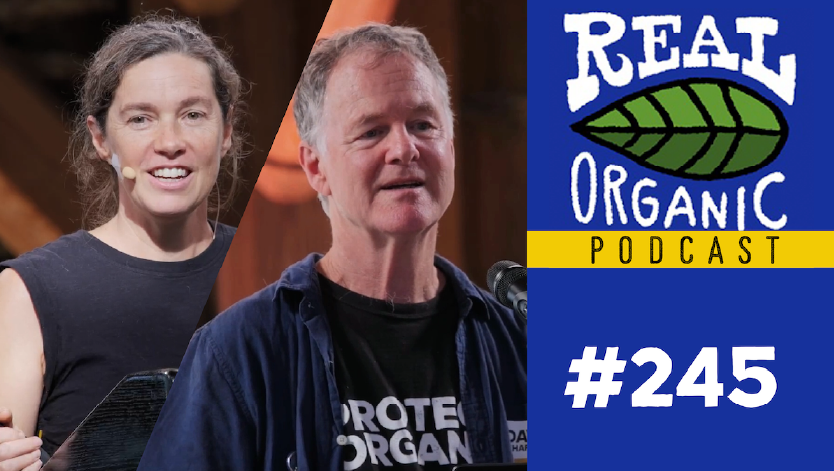Episode #157
Tim Bowles Part 2: Climate Smart Agriculture Includes Tillage
Welcome! You can subscribe and download episodes of our show through your favorite podcast app.
You can also subscribe to receive the video version of each episode on our YouTube channel.
Our Tim Bowles interview has been edited and condensed for clarity.
Linley Dixon interviews Tim Bowles:
Tim Bowles 0:00
I don’t think it helps to be ideological about what is or isn’t, and this I think relates to your point around, well, if you know, if organic farmers are using tillage than they can’t be climate smart. That’s bogus, right. I mean, we know from a lot of research on farm and at experiment stations that organic systems are, whether they’re often in spite of their tillage they are accruing soil carbon, right? They don’t have the embodied greenhouse gas emissions that are present in synthetic fertilizers and other non-renewable inputs. You know, they can have reduced nitrate leaching, right, and all of this is in the context of tillage, or most of it. So you can’t tell me that like, you know, because they’re tilling they don’t count as being climate smart.
Linley Dixon 1:04
Welcome to The Real Organic podcast, I’m Linley Dixon, co-director of the Real Organic Project. We’re a grassroots farmer led movement with an add-on organic food label to distinguish organic crops that are grown on healthy soils, and organic livestock that is raised on well managed pasture. You just heard from Tim Bowles, he’s a professor at UC Berkeley’s agroecology lab, and his research focuses on enhancing farm biodiversity, and various ecological practices. So if you tuned in last time, you heard my interview with Dr. Bowles about some of the incredible work that soil microbes do for us. Today, I’m sharing my conversation with him at this year’s EcoFarm, which goes into a much more nuanced understanding of no-till systems, and how that’s greatly needed for better agricultural policies. You’ll learn that no-till actually causes soil pore size and nutrient availability to decrease in the first decade transitioning to no-till, and how this can be a huge problem for farmers. Like everything these days, we are greatly in need of greater understanding and a much more nuanced conversation around no-till especially, and Dr. Bowles delivers just that.
Linley Dixon 2:28
So Tim we left off last time we were talking where we did kind of a deep dive into some of the stuff that’s going on in the soil and that’s so exciting to farmers. And then we started talking about tillage right at the end, and it’s such a hot topic right now…
Tim Bowles 2:43
Yeah definitely.
Linley Dixon 2:43
Because there are so many political implications for what gets funded as climate smart, and what is the best kind of farming that we should really be striving towards. And we had a whole day yesterday for the EcoFarm pre-conference where we talked about this issue. So I thought maybe we could start off with just some of the basics. The take home that I got from yesterday was that there are a lot of trade offs, and so let’s just kind of dive into what some of those trade offs are for tillage.
Tim Bowles 3:10
Sure.
Linley Dixon 3:11
The shocking thing to me was, I think you were presenting data on no-till, and all of it was chemical no-till. Yeah, there’s very little organic studies out there. So maybe we can even start with that.
Tim Bowles 3:24
Sure. We can start in either place, but yeah, it’s definitely true that there are very few organic no-till studies out there, especially on what happens in the soil, right? I mean, there are a number of them who are looking at changes in crop yields or crop performance, but the vast majority of work out there right now is on chemical no-till, right? And that’s, you know, herbicide dependent and often in the context of systems that are highly simplified in other ways to very low crop diversity, often lacking cash crops.
Tim Bowles 4:00
And so what we know about no-till from the scientific literature is in terms of the time it takes to transition from a well performing tillage system to a well performing no-till system, or what types of changes in the soil we might expect as against the backdrop of the broader context of these conventional systems, right, where they’re lacking and these other critical elements that might help an organic farmer make this transition faster or lead to different types of changes in soil, right, because our organic farmers we would expect at least to see more cash crop diversity using cover crops. Thinking more holistically about the system, rather than thinking about no-till as this practice that is dependent on you know, on herbicide and often transgenic crops to kind of match with those chemical inputs.
Linley Dixon 4:58
And I feel it’s always missing from the conversation in what you hear from farmers is that conventional no-till has a lot of drawbacks in terms of greater erosion, which I’m surprised to hear, and I don’t know if academia is talking about some of these. Fertilizers are surface applied…
Tim Bowles 5:16
Right.
Linley Dixon 5:17
And then any cracks in the soil because these fertilizers aren’t tilled in, they kind of run down the cracks, and there’s greater eutrophication in waterways from it. Greater gully erosion from these cracks, and so I’m wondering if that’s being discussed at all in academia?
Tim Bowles 5:31
I think, interestingly enough, you know, I don’t think the nuances there yet in academia, well, I’ll say really broadly, right, and with that type of nuance, I think no-till systems are still considered to be really beneficial for erosion, and preventing erosion. But some of the changes that we see in no-till systems, especially early on, is that we actually can see a decrease in infiltration in the surface of soil. You know one of the things that tillage does, especially soon after tillage in the months following tillage is it really creates a lot of macro pore space, it really, you know, anybody, anybody that still would know this, it fluffs up soil and that’s one of the functions of it is to kind of create a lot of opportunity for water to infiltrate. And so no-till systems where those macro pores aren’t reforming, these larger soil pores aren’t reforming very quickly, we can see reduced water infiltration, that could in turn lead to increased erosion in certain circumstances.
Linley Dixon 6:41
I actually want to pause on that, because I was surprised. I thought, if you till…
Tim Bowles 6:46
Yeah.
Linley Dixon 6:47
You’re actually going to have the micro pores, like you’re gonna get rid of those earthworm tunnels and things like that.
Tim Bowles 6:53
Right.
Linley Dixon 6:53
So you would have kind of a more….
Tim Bowles 6:55
And this may just, you know…
Linley Dixon 6:56
So I was surprised to hear your results yesterday that, like, no till is actually more micro pore space, which causes it to be harder to infiltrate. And that’s counterintuitive.
Tim Bowles 7:07
At least early on in a transition period. And again, this is based on a lot of understanding from more conventional systems. But we’ve seen some similar results, at least in a very small trial that we’ve done in Berkeley.
Linley Dixon 7:20
With organic systems?
Tim Bowles 7:21
Yeah, it was an organically managed system, it wasn’t certified as part of our research station. But part of this is a little bit about terminology, and what we mean by by micro pores and macro pores, right? You know, half of the soil is void space is pore space, right? So by volume, roughly, that’s half is solid, and half is this pore space. Yesterday in the session, and maybe you could link this, there’s this new research that is able to visualize the pore space and soil at an extremely high resolution, like teeny tiny, like micron level resolution.
Tim Bowles 7:37
It was like a cave.
Tim Bowles 8:01
Yeah, like a cave like, yeah, and all these tunnels, you know, big ones, small ones, and if we measure the diameter of all of these pores and in soil, and we look at the proportion of the different sizes of pores that we see, we get kind of this distribution from like large pores, what we call macro pores down to itty bitty bitty tiny ones. And these macro pores are the ones that are really formed by earthworms, by the channels left from roots that have you know, moved through grown through soil and then died and decomposed and then they leave behind the channel. Those are those macro pores that are really important for water infiltration. And they’re really important for air movement in and out of soil. These micro pores are smaller, the cut off is about 50 microns. So that measurement, like that unit may not it’s hard for us to visualize that, the human hair is about 80 to 90 microns in diameter. So it’s…
Linley Dixon 8:02
So we’re talking that width.
Tim Bowles 8:05
We’re talking that width, we’re talking like smaller than a typical human hair, right. And these are where a lot of the water is held in soil, the water that’s available for plants. And one of the functions of tillage is, one of the things that it does is it mechanically instead of by the action of earthworms and plant roots is it creates more of these larger pores. But you can imagine that especially early on in the phase of after you cease tillage, you know you’ve broken up a lot of these aggregates and yes, there’s some of these larger pore spaces that have resulted early on but then that all starts to settle, right. And as those soil aggregates that are kind of left, we call them fragments sometimes in the context of tillage rather than aggregates because they’re not formed by biological processes, they are formed by mechanical processes.
Tim Bowles 9:58
They start to settle out, and so he’s actually do often see a decrease in these larger pore sizes during early on in the phase of transition to no-till. And a relative increase in the size of these smaller kind of micro pores. Now, one study, and there hasn’t been a lot of research on like the time of transition from till to no-till, and the time of what’s happening over time. But there was one interesting study that showed after about 5 to 10 years, you do see then the reformation of these macro pores and no-till systems, because some of that biological activity is coming back. The earthworms are coming back, the, you know, channels left by plant roots are beginning to really play a role. But that takes time.
Linley Dixon 10:53
And the room just kind of was like
Tim Bowles 10:55
Yeah the room was kind of like ah this really
Linley Dixon 10:57
Yeah, 5 to 10 years?
Tim Bowles 10:58
Yeah 5 to 10 years, what kind of yield hit are we going to take over 5 to 10 years? And so that’s real, yeah. Thats real.
Linley Dixon 11:03
So lets talk about that yield hit, and then nitrogen and oxygen and kind of how they’re really intimately tied?
Tim Bowles 11:11
Absolutely, yeah. So this, I mean that was a common sentiment yesterday, among these veteran growers, you know, I’d say, and I think somebody said this in the room, you know, these might be among the most experienced specialty crop growers in the country. You know, these are folks who really were pioneers early on in the organic movement. And they’ve been experimenting with no-till, and pretty much across the board, noted pretty dramatic yield declines. Now, these were, as I understand it, you know, they had tried no-till for kind of one year, so these were often first year numbers. But, you know, close to yield failure, in some cases, other cases, not so bad.
Tim Bowles 11:56
And they noted some ways in which they could mitigate those yield declines through the use of plastic and that kind of thing. But one of the at least from their experience, and their observations, one of the potential reasons that they were seeing yield declines is a reduction in nitrogen nutrition in the crop. And I say specifically nitrogen nutrition rather than nitrogen availability in the soil, because I want to like to separate out the nitrogen that’s available to plants into two sort of, I’ll say categories. One is like, what we often what organic farmers are thinking about a lot, which is the mineralization of nitrogen from organic matter, right, the creation of plant available forms of ammonium and nitrate, from organic nitrogen.
Linley Dixon 12:46
From microbial breakdown.
Tim Bowles 12:46
From microbial breakdown, exactly. And that’s the first one, right? The access that plants have to that nitrogen in no-till systems, when we see this reduction in macro pores, we might also see a reduction or a change in plant root distribution, plant root growth, it’s harder for them to penetrate through soil that has lost a lot of these macro pores. There was some data that was showed yesterday showing the penetration resistance, how hard it is to push through soil, and especially in the surface layers, it was harder in a no-till system to kind of push through that soil. So this lack of nitrogen nutrition or an apparent sort of lack of nitrogen nutrition in these early phases of the no-till transition for these organic farmers may have been either a result of changes in the breakdown of organic nitrogen by microbes and/or a change in how the plant roots are able to access that nitrogen because of the changes in soil structure that have occurred. I’ll pause there in case I’ve lost us here in the depths of nitrogen cycling, and you want to ask uh
Linley Dixon 14:18
No that makes sense. I think it’s so important here to keep in mind time, and so this is all initially it is harder and this goal of 5 to 10 years. That’s where we’re trying to get to and maintain. Do you think, and maybe we just don’t have the science yet, do you think that organic farmers could get there quicker because maybe the soil life can rebound more quickly? Because there’s the chemical inputs aren’t there to kind of suppress that activity?
Tim Bowles 14:47
I think that there’s reasons to expect that it could, and I don’t think we have solid evidence from the scientific side of things. Growers out there who have tried this may have experiences that are quite relevant here, right, but at least from the research side of things I don’t know of a lot of work looking at that transition phase and whether it’s faster at an organic system, a really well performing organic syste, but here are a few reasons why I think it could be. First is the reasons that you mentioned, which is, there’s already would tend to be more microbial life in an organic soil, and the reformation of soil structure is dependent on soil life, right? We would not have soil structure without soil life, we would just have this, you know, collection of sand, silt, and clay all packed down together, right. And it’s dependent on all soil life, it starts with microbes, the microbes produce these biopolymers, almost like microbial glues that begin to hold together the primary particles and soil, the individual grains of sand, silt, and clay, that begin to be sort of bound together by these microbial glues.
Linley Dixon 16:11
And are these glues like their poop? Like are they just getting rid of them as waste?
Tim Bowles 16:16
No, they, my understanding is that they are effectively creating their habitat…
Linley Dixon 16:22
Okay.
Tim Bowles 16:23
In a lot of ways. So no, these aren’t just their poop, these are particular substances.
Linley Dixon 16:30
That they’re excreting for their own benefit.
Tim Bowles 16:31
Yeah, they’re EPS, extracellular polymeric substances, is I believe the term that’s used for them…
Linley Dixon 16:39
The big category.
Tim Bowles 16:39
Yeah the big category, right. And those are these little collections of individual grains of sand, silt, and clay, then themselves begin to be held together by things like fungal hyphal strands, and then going a little bit bigger, those are, end up being held together by you know, some fine plant roots, right. And so we get this collection, these formation of aggregates, from the little itty bitty tiny bits to the bigger macro aggregates and everything in between, and it’s all dependent on soil life. And it’s not just the microbes, it’s the bigger critters as well, it’s the beneficial nematodes, it’s the Collembola and the earthworms of course, which are you know, were probably more familiar with. Those are also forming these larger bio pores,
Linley Dixon 16:40
Mites.
Tim Bowles 16:40
Mites, yeah right.
Linley Dixon 16:49
Who farm fungi.
Tim Bowles 17:06
Yeah, exactly right. Everything is playing a role in the reformation of soil structure, so if an organic soil, kind of a circle back around, if an organic soil already has more abundant life and that life can be really primed with a lot of organic matter availability whether that’s through compost or through cover crop residue, live roots are super important, or crop residue, you know, any of these sources of organic matter that really fuel all of this, like microbial life, then yeah, I would expect that soil structure to reform faster. Now, there is one caveat here, which is that especially with these larger bodied organisms, the mites and the Collembola and the earthworms, even some of the larger bodied beneficial nematodes, the predatory nematodes that are eating, you know, some of the plant parasitic nematodes. Those are the organisms that also we tend to lose the most in tilled systems, because their bodies are big enough that they’re actually physically disrupted from the mechanical process of tillage.
Tim Bowles 18:56
And so there’s some, you know, ecological questions here too of like, okay, well, if these organisms have been there abundance can be much much lower in a tilled system, where do they come from, to sort of, reconstitute that soil. Now they can travel from deeper in the subsurface sometimes, right, of course, earthworms are migrating up and down all the time. So they may be around, they may be able to get there and but it is a process of restoration, you can think of it that way too, right? And restoration is hard, anybody that’s worked in, you know, trying to restore a grassland, you know, or any other ecosystem like restoration is hard.
Linley Dixon 19:43
It’s takes time.
Tim Bowles 19:44
It take time, yeah.
Linley Dixon 19:45
So, I want to kind of rest on the very opening or like spend some time on the very opening of the day. We looked at soil health principles, and Tom Willie, put them up there and I see this all over the place, and there’s five.
Tim Bowles 20:03
Right.
Linley Dixon 20:03
And the NRCS, you know, does it and so they’re kind of all over the place, that any regenerative website will do it.
Tim Bowles 20:09
Sure.
Linley Dixon 20:09
And I leaned over to Scott Park next to me and I go, which one’s missing? Do you know which one was missing?
Tim Bowles 20:14
An in organic matter inputs? Or?
Linley Dixon 20:17
It was reduction in chemicals.
Tim Bowles 20:21
Oh, reduction in chemicals, yeah right. You know, this is part of the problem with the regenerative agriculture broadly. Right, but go ahead, I’m sorry I cut you off.
Linley Dixon 20:29
No Scott goes, well that’s obvious we’re talking about soil health, and I go it’s actually not that obvious, I think it’s missing for a reason.
Tim Bowles 20:35
Yeah. I think, you know, I think this has been a long criticism of regenerative agriculture, right, and I think the soil health principles, of course, are very much linked in with the regenerative movement, and that we sort of gloss over the chemical side of things a lot. And we started out talking about the dependence of conventional no-till systems on widespread herbicide use, which has, you know, some, I’d say, unclear the herbicides, at least have, I think, some unclear impacts on soil and soil health, but clearly things like the fungicides and, you know, the soil fumigants and this kind of thing are very clearly impacting soil health and soil life.
Linley Dixon 21:30
But even fertilizers because, you know, we talked in the last session how even if you’re gonna do experiments with mycorrhizae, it’s like, you can’t have phosphorus there, because then they’re just not going to make those interactions, right? So isn’t fertilizer a big reason…
Tim Bowles 21:43
Fertilizer can also be an issue, I mean and I’ll say like, just to, you know, we’ve talked a lot about, you know, bringing nuance to these conversations, and phosphorus can be an issue with organic too.
Linley Dixon 21:53
True, yep.
Tim Bowles 21:53
Particularly, if…
Linley Dixon 21:53
If there’s a lot of manure inputs.
Tim Bowles 21:56
If there’s a lot of manure inputs, right, the nitrogen to phosphorus ratio of a lot of organic inputs is low, and if you’re basing the rate of that application on the nitrogen needs, then you’re going to be over applying phosphorus.
Linley Dixon 22:09
Yep.
Tim Bowles 22:10
And we’ve seen this in long term experiments on organic that they tend to be accumulating soil phosphorus at a higher rate, just to bring a little bit of nuance there. But absolutely.
Linley Dixon 22:24
I think that’s an important distinction, because a lot of the farmers that I’m talking about, who are some of the best farmers in the country, like the Emily Oakleys of the world, Mark Askegaard, they don’t apply anyone manure, and they’re depending on their cover crops for their fertility, and the question is, where do these guys sit? Because they, you know, I mentioned yesterday intelligent tillage, where they’re incorporating a lot of biomass once a year, right before they’re planting.
Tim Bowles 22:50
Right.
Linley Dixon 22:51
So is that climate smart? Or, this is important right now, because our government is putting… I mean they just put $3 billion dollars into climate smart, and those aren’t the farmers that we’re getting funded because they till.
Tim Bowles 23:04
Well, and what I would love to see is, well, a few things, one, multiple pathways to, you know, to getting to what’s climate smart. There’s no one definition of one system that represents “Oh, this is climate smart.” Right. I think growers can get there in a number of different ways.
Linley Dixon 23:26
Okay, lets unpack that.
Tim Bowles 23:28
Well in the sense that, I don’t think it helps to be ideological about what is or isn’t in the, and this, I think, relates to your point around, “Well, you know, if organic farmers are using tillage then they can’t be climate smart, that’s bogus, right? I mean, we know from a lot of research on farm and at experiment stations that organic systems are, whether they’re often in spite of their tillage, they’re accruing soil carbon, right? They don’t have the embodied greenhouse gas emissions that are present in synthetic fertilizers and other non-renewable inputs. You know, they can have reduced nitrate leaching, right? And all of this is in the context of tillage, or most of it. So you can’t tell me that like, you know, because they’re tilling, they don’t count as being climate smart. And so I think the….
Linley Dixon 24:36
I can’t tell you, but that’s the story in Washington.
Tim Bowles 24:39
Sure.
Linley Dixon 24:39
So we have to overcome this.
Tim Bowles 24:40
Sure, yeah, exactly. Right. But I’m also not surprised that the conventional industry is being quite agile and opportunistic here to reframe what they’re doing in the context of climate smart. You know, the chemical dependent no-till is not a systems change, it’s not a systems redesign, you know? It is a tweak to an industrial system so there’s nothing about it that is fundamentally changing that agricultural system. You know, now do I also think that there should be at least some pathways for conventional farmers to improve their practices and to, you know, include individual practices that might be more climate smart? Yes, and, you know, I think we get a lot more, at least in the conventional systems, I think we get multiple benefits out of things like integration of cover crops.
Linley Dixon 25:46
With biomass.
Tim Bowles 25:47
With biomass, yes.
Linley Dixon 25:48
That gets forgotten a lot of times too, I think that a lot of people are tilling them under when they’re a couple inches above the soil, because the timing of getting their crop in at a certain time.
Tim Bowles 25:57
Sure.
Linley Dixon 25:57
Organic farmers tend to say, “No, I need the biomass, and I’ll plant later.”
Tim Bowles 26:01
Right, so yeah, I mean, it’s the biomass that’s creating the ecosystem services, right? Increases in crop rotational diversity, right? These are things that provide our, you know, tried and true ways to provide a lot of benefits not just for climate, but also for biodiversity for, you know, nutrient availability and reductions in nutrient losses, reductions in the need for non renewable inputs. I think that those types of practices should be available for conventional growers, to move towards more kind of climate smart or regenerative or whatever term we’re using. But conversely, you know, the idea that an organic farmer is not climate smarter, because they’re continuing to use tillage in a system that is otherwise functioning really well and not relying on any non renewable inputs, I mean, that doesn’t make much sense to me.
Linley Dixon 27:08
What were your thoughts on that? “Well, I’m a tweener confessions” yesterday, these farmers that are tilling a little bit, you know?
Tim Bowles 27:14
Yeah. I think that’s maybe where there’s a lot of sweet spot. And these questions that were posedby Phil Foster and Scott Park and others around, “Well, how much tillage can I get away with?”. I want to do a little bit. And whether that’s for working in biomass, terminating cover crops, you know, Phil Foster was talking about he needs to undercut his cover crops.
Linley Dixon 27:39
Uh huh, at nine inches.
Tim Bowles 27:40
Yeah, and how much can we get away with, to do what we need to do in these systems to make our cover crops work, to get the seedbed that we need. For whatever reason it is, how much can we get away with and still get a lot of the benefits that we would see in a no-till system? And I think that’s the critical question.
Linley Dixon 28:08
Because the benefits of getting that biomass in for nutrient availability might outweigh the two inches that Scott Park goes under or something.
Tim Bowles 28:16
Right, and you know, these farmers, they’re amazing people, right? And they’re always about continual improvement, and so maybe this is part of their broader transition. Maybe in a few decades, we will get to the point of having the confluence of knowledge and technology and experience to be able to get to a really a complete no-till system. Maybe we will.
Linley Dixon 28:36
And organic.
Tim Bowles 28:37
And organic. But for right now, we can try to be judicious about what’s going on, and that’s good for the farmers too, right? If they’re reducing their passes, if they’re reducing the depth of tillage, they’re also reducing your fuel use, right? I mean, these aren’t things that provide benefits beyond just the soil, too. So this certainly gave me a lot of fodder for like, “Oh, these are a lot of research questions that we could potentially help out with.”
Linley Dixon 29:01
Yeah.
Tim Bowles 29:02
In terms of trying to answer some of the like, “Okay, so if the top couple inches, three or four inches is disturbed, do we see, I’ll say, more natural soil structure beneath that, and is that providing the benefits that we hoped that it would?
Linley Dixon 29:19
Let’s talk about, I always see this fungal to bacterial ratio, and I kind of brought up the question, is this meaningful based on what those fungi are actually doing?
Tim Bowles 29:30
Yeah.
Linley Dixon 29:30
And often when we say fungi in our circles, we’re talking about arbuscular mycorrhizal fungi and not necessarily saprophytic fungi that are breaking all this biomass down.
Tim Bowles 29:39
Yeah.
Linley Dixon 29:39
And so is that measurement even helpful?
Tim Bowles 29:43
Yeah.
Linley Dixon 29:44
I question it all the time. I’m like, what are we actually looking at here? And what depth? It’s a confusing world out there.
Tim Bowles 29:51
It’s certainly been called into question about its utility. And I don’t know the history of it well enough to speculate, but I am a bit cautious or skeptical that it’s a really useful metric to aim for, that is increasing the fungal to bacterial ratio. You know, fungi are important. The mycorrhizal fungi are playing these, we talked about it last time playing these incredibly important roles in helping plants access nutrients. Amazing scientists, Jennifer Pett-Ridge, from the Lawrence Livermore Laboratory, amazing microbial ecologist brought up yesterday about how some of the carbon in fungal cell walls is the same type of carbon that we see as the most persistent soil carbon in soil. So the carbon that these fungi, the saprophytic fungi, have acquired through the breakdown of organic matter, and then decomposed as their bodies die. That’s some of the carbon that’s really linked to longer term carbon accrual, so the fungi are clearly important.
Tim Bowles 31:05
And bacteria are too, right? The bacteria are able to grow really quickly, their populations can increase and decrease really quickly, so they can respond to, say, a big pulse of organic matter availability, like when a cover crops turned in, and they can turn that into nitrogen availability. So they’re fast, and both sets of organisms are important. And another thing that Jennifer Pett-Ridge mentioned yesterday was that they’re also acting a lot in concert with each other. Fungal highways that are transporting bacteria from one little soil microsite to another, across an air gap maybe that they wouldn’t otherwise be able to travel and allows them to get to a new little juicy bit of organic material, a new habitat. So there’s all kinds of ways that fungi and bacteria are working together, and they play some complementary and different roles. Bacteria tend to have a much broader suite of metabolic capabilities in terms of what types of materials that they’re able to break down.
Linley Dixon 32:28
With the help of bacteria.
Tim Bowles 32:29
Yeah, right. And so it’s both and in my mind, and I think where this comes up is, I’ve seen in a couple of contexts, farmers who have been, you know, having some consternation about “You know, I’ve been doing all these things on my fungal bacterial ratio, it just stuck, it’s just not moving anywhere.” I’m like, I don’t know that that’s a problem.
Linley Dixon 32:59
Uh huh. We should be talking about, maybe what is there? So, it’s amazing with the sequence data now, we can take a look at everything that is present. Do we have any way of saying abundance?
Tim Bowles 33:11
From that sequence data?
Linley Dixon 33:12
Right, it’s a nice even distribution, or maybe we’re seeing a lot of this, but not a lot of this, you know? Do we have that capability?
Tim Bowles 33:19
We are growing in that capability, there’s some really cool new techniques now that actually allow for sequencing and identification of actually not just microbes, but also soil fauna. And a lot of these methods are able to tell us who’s present, and a little bit about their relative numbers like, “Oh, well this group is probably more than this other group.” It’s a little bit trickier to get to like the absolute amount, like to translate that into this many pounds of biomass per acre, for instance. But certainly, we have these DNA tools that are allowing us to not only catalog the microbial community, but also the soil faunal community. And by faunal, I mean the larger bodied animals down there, the nematodes and the mites and the Collembola and all of that.
Linley Dixon 34:14
And it’s so important because I saw a study, and this was a peer reviewed, published study about how glyphosate is good for the soil health because there’s like a bacterial abundance right after you spray it and they’re breaking it down.
Tim Bowles 34:29
Right.
Linley Dixon 34:29
And so it’s like, Well, okay, we got a lot of this bacterial mix,
Tim Bowles 34:29
Right.
Linley Dixon 34:29
That likes to break down glyphosate and that’s soil health according to this article, right? Sometimes it’s so frustrating, it’s like, well, it’s published and so, therefore we know. You know? Sometimes we have some trouble in peer review, too. Yeah, just one study isn’t all that is needed to develop a good picture.
Tim Bowles 34:58
No, not at all, and also as terms like soil health become more prevalent and prominent and, you know, it’s inevitable we’re going to see people trying to co-op that, a little bit.
Linley Dixon 35:14
Yeah, it’s just kind of the way things are. I remember when Dave interviewed Miguel Thierry, he asked him, “What is the difference, in your mind, between organic and agroecology? And Miguel said, “Well, there’s a political component to agroecology, and so we have a responsibility as scientists to be a little bit more active politically.” And I don’t know if you agree with that, if you see that as part of your role in agroecology?
Tim Bowles 35:39
Yeah, I absolutely do. And that might make some scientists feel really uncomfortable.
Linley Dixon 35:48
Yeah, it’s not what we were trained to do. Yeah.
Tim Bowles 35:51
And, so at the risk of being on a soapbox a little bit, I’ll share I think why I feel that way, and why I think it’s also okay for scientists to do this. The other side, industrial agriculture and all of the different ways that our society props it up, they’re not shy about being political. In fact, they’ve had incredible political success. That’s why most of our USDA policies are aimed at supporting that. So scientists don’t have, at least I hope we don’t have the luxury of just sitting on the sidelines in this. Now, others might say, “Well, what about your credibility? Doesn’t that make you biased?” And I’d say no, because what’s important is that we’re transparent about how we ask questions, what questions we choose to ask, and that we’re rigorous. So if the data that I’m collecting, don’t tell the story that I want it to say, I’m not going to tell a different story, I’m not gonna hide that.
Tim Bowles 37:17
And so, I think there’s a misplaced notion around what objectivity or neutrality is. I think as humans we are not able to be objective or neutral, even the questions that we choose to ask if we can pretend they’re apolitical, but they’re never a political. And so a scientist that is like, “Well, I’m just going where the science goes, or I’m responding to the questions that are coming from the farmers” Well, what farmer are you choosing to work with? Who are you choosing to listen to? So we can be transparent about that. And so I would argue them in a lot of ways that these principles of transparency and rigor are really what we need, both in how we ask questions, how we share our data, right? Data Transparency is becoming a much bigger thing now, so that others can validate the conclusions that we draw from studies. So that was kind of a soapbox, but to step back to the broader question.
Tim Bowles 38:35
And for me, the political side of it can be being in close touch and close contact and conversation and ongoing collaboration with advocacy groups that are based on understanding what farmers are looking for, what their needs are. With farmer organizations, organizations like Community Alliance with Family Farmers here in California that does amazing work on the ground with technical support, but also understanding what types of policies need to change in the state of California or federally to help small and midsize farmers thrive. And what kind of information needs might I be able to help with, and being able to design research that aims at those information needs for the types of policy change that we’re aiming for. Short answer to your question is yes.
Linley Dixon 39:44
And because climate is the political issue of our time, I kind of want to dive into some of what Hannah talked about yesterday, which was the most challenging scientifically. So we’ll see if we can do it. But I also you had your pool of Nitrogen and I want to get there too.
Tim Bowles 40:00
Sure.
Linley Dixon 40:01
Because I had a big light bulb moment when you described that. So I want to do both of those things, and I think they’re related, and I think they’re related to climate because nitrous oxide emissions came up, too. And so I’m wondering if we can kind of unpackage some of both Hannah’s and your presentation on this interplay between nitrogen, what no-till does to nitrogen availability. You talked about increased nitrous oxide emissions from no-till. Let’s start with that, why does that happen?
Tim Bowles 40:32
Sure.
Linley Dixon 40:33
I’m wondering if it happens more in the chemical no-till than it would in an organic system.
Tim Bowles 40:40
Right.
Linley Dixon 40:40
And then we’ll go from there and talk more about nitrogen?
Tim Bowles 40:43
Sure. Well, let’s start with a little bit of my favorite topic, the nitrogen cycle.
Linley Dixon 40:49
Okay, good.
Tim Bowles 40:51
Nitrogen, the nitrogen cycle and all of the different forms that nitrogen can take in soil from organic nitrogen, leftovers of compost or plant material, to ammonium and nitrate, to production of gases, like nitrous oxide. The conversion of one of these forms into another is really dependent on oxygen, which in turn, is really dependent on water. So these are what are called reduction and oxidation chemical reactions. So we don’t need to go too deep into what that is, but the point is, is that the reactions that change one form into another are really dependent on the amount of oxygen that microbes have available, because different microbial groups are active during different levels of oxygen in the soil. So we talked earlier about how with no-till systems, at least what we understand from largely chemical, conventional based no-till systems, that at least early on, we see a reduction in macropores and an increase in micropores, that would tend to limit oxygen flow into soil and make them a little bit more anoxic, that is how they have a less oxygen relative to a tilled system.
Tim Bowles 42:22
And that also might be because they have a little bit more moisture in them, so that pore space, instead of having air, it has water. And when that happens, the two processes in soil that lead to nitrous oxide. There are two of them, one is nitrification, so the conversion of ammonium into nitrate. And the other one is denitrification, which is the conversion of nitrate back into atmospheric or inert forms of nitrogen. That one in particular, there’s more denitrification, there’s more nitrous oxide emitted as kind of a byproduct when soils are really wet, and when there’s less oxygen available. So I hope I haven’t confused everybody but to try to reframe it in a simpler way, which is no-till soils, we tend to be a little bit wetter, a little bit more oxygen, that would tend to make the nitrogen cycle produce more nitrous oxide.
Linley Dixon 43:28
A little bit less oxygen.
Tim Bowles 43:30
Sorry, a little bit less oxygen. Yeah, a little bit less oxygen and a little bit more nitrous oxide. Now the other really important part of this because you mentioned potential differences between conventional and no-till systems, is that the substrate or the chemical form of nitrogen that is leading to nitrous oxide is nitrate. We would tend to see a lot more nitrate in conventional systems that are using synthetic fertilizers, either because that’s the form that they’re applying directly, or if it’s urea, for instance, it’s going to be very quickly converted into nitrate. So that tends to be a lot more nitrates sitting around then conventional systems. So yeah, I do think that nitrous oxide production, as a result of the transition to no-till, would be higher in a conventional system than an organic system, most likely.
Linley Dixon 44:25
Okay.
Tim Bowles 44:26
Yeah.
Linley Dixon 44:26
And then can we get to how confusing soil measurements might be? If you get a low reading, you presented this graph where there were two really low readings and one of them was actually you need to apply more nitrogen based on this reading, and the exact similar reading was no, you’re just fine.
Tim Bowles 44:47
Yeah.
Linley Dixon 44:48
And you envisioned it with, “Okay, so we’ve got a small pool of nitrogen, but let’s talk about nitrogen flow.”
Tim Bowles 44:54
Right.
Linley Dixon 44:54
So you put this beautiful image in my head of like a huge waterfall and then a huge exit out of that small pool, and then you’re fine if that’s your situation. So what type of a situation might have a huge waterfall coming in, in the soil, and a huge exit from that small pool?
Tim Bowles 45:10
Maybe I’ll scaffold a little bit, to get here.
Linley Dixon 45:12
Yeah, explain it better than I did.
Tim Bowles 45:15
Well, there’s just some interesting history that I think is important to remember. Plants and agricultural systems mainly take up two forms of nitrogen, ammonium and nitrate. And for a long time, that’s been the primary focus of fertility in agriculture, and that dates way, way back to the 19th century. In part because it was a chemist, Justus von Liebig, who identified which nutrients in soil that plants needed. And since then, there’s been a strong sort of chemistry focus on fertility and nutrition in an agricultural context. Also, with the explosion of synthetic fertilizers in the early 20th century, that can directly add these inorganic forms of nitrogen, ammonium and nitrate, that has kind of reinforced this focus on soil chemistry. So for a century and a half, there’s been this kind of laser focus on ammonium and nitrate as the forms of nitrogen that plants can take up. So it would make sense if we measured those, as to say, “How much nitrogen is available for crop?”
Tim Bowles 46:49
Well we should measure the forms that they’re taking up, that makes sense. Until it doesn’t make sense. When we measure those forms of nitrogen, if you send your soil off to a test lab, and they send you a report back and they say this is your nitrate value, you’re measuring what’s called the pool of nitrates in the soil, just what’s kind of sitting around. However, that’s not really appreciating how dynamic, how quickly that pool can change. So that waterfall sort of imagery that you mentioned, is one that I like to use, because if we bring in the biology, as well as the chemistry into this understanding, we remember that there are these microbes around and they’re rapidly breaking down organic matter. And as part of that, they’re releasing ammonium through the process of mineralization. So we can imagine that process of microbial mineralization as this waterfall coming into our pool of available nitrogen. So I like to, you know, if anybody, over the summer, looks for a little swimming hole up in the mountains, we’re lucky here in California, we can go up to the Sierra foothills find a beautiful little swimming hole, it might just be a little swimming hole but there might be a hell of a lot of water coming into it, especially after a good year of snowmelt.
Tim Bowles 48:31
So what’s going out, what’s the outflow from that? Well, the outflow from that is what plants are taking up, and it’s also what microbes are taking up as well, because microbes are also cycling these forms of nitrogen, they release it from organic material, and then others might grab it up, that ammonium and that nitrate, as well. So plants and microbes are both taking it up, so that’s the what’s coming out of our little mountain stream pool. Well, we could imagine that we might have a little pool sitting around in our mountain stream, but we have a big waterfall coming into it and a big outflow going out. And so if we imagine part of that outflow is what plants are taking up, well they might not be nitrogen limited, even if there’s a small pool around, because there’s so much flow in the system. Now, we might contrast that with a conventional system where there’s not a lot of soil life, where microbial activity is not as high.
Tim Bowles 49:27
There’s not as much kind of juicy organic matter sitting around, whether that might just be a trickle coming in to that pool. And so the size of that pool might be really important and indicative of nitrogen availability. So when we measure in soil nitrate, particularly in organic systems, it can be kind of tricky to interpret. This was what the data that you mentioned was from a study about 15 years ago that I did with organic growers, all of whom are growing tomatoes as part of their larger diversified operations, but that was the common crop I was looking at. And after measuring all sorts of things over the whole growing season I kind of found three kind of groups of farms. One had low levels of soil nitrate, the other two, or excuse me, two had low levels of soil nitrate, this pool of nitrogen that we’re measuring, and a third had higher levels.
Linley Dixon 50:36
Can I step back, was this organic or a mix?
Tim Bowles 50:38
No, this was all organic.
Linley Dixon 50:40
All organic, maybe you said that and I had missed it. So you had three types?
Tim Bowles 50:46
Three types, and in one group that had low nitrate, we also saw low yields and low amounts of nitrogen in the leaf tissue of the plants, so those systems did appear to be nitrogen limited. But in another group that also had similarly low values of soil nitrate, they had yields above the county average, which included conventional processing tomatoes. And the nitrogen and leaf tissue was just fine. So soil nitrate, which we rely on so much as a metric of nitrogen availability was like, well it could either mean you have a problem, or it could mean you’re doing great.
Linley Dixon 51:26
Yeah.
Tim Bowles 51:28
And so it becomes tricky to have this measurement that is really a static measurement of a soil chemical constituent in an organic system, where if you’ve done a lot of work to build up soil life and to build up organic matter over time, and remit really may not be telling you the full story.
Linley Dixon 51:49
I kind of see it as like your waterfall and pool image works really well but like a roundabout too. So you’ve got a lot of cars coming in, and then a lot of cars going out.
Tim Bowles 51:58
That’s right, yeah. A roundabout.
Linley Dixon 51:58
Like, how busy is this roundabout? When I hear all of these stories, I’m like, why are we talking about tillage, and you can correct me if I’m wrong, I’m like, we should be talking about organic matter, which is so central to organic farming, we’ve always without any science to back us, right? The scientists thought we were all loony forever, like before my time, I always knew that there was something to organic matter. And whether you’re a chemical or an organic system, let’s start talking about that though, the biomass that we can include through cover cropping. I think that needs to be the question, not tillage, and maybe there is something to tillage over, you know, longer terms if we can get there as like this ultimate pedestal. But I think first, we need to start talking about organic matter.
Tim Bowles 52:46
Yeah, and I would add a couple of things there. One is that what excited me about the conversation yesterday was that it was a platform, and that was this conversation around no-till and organic systems, was that it became kind of a way of talking about, I’ll say, more system redesign, stepping back a little bit. So it’s not just organic matter, but it’s also living roots. It’s also presence of mulch, which is a form of organic matter,
Linley Dixon 53:23
The composition of the organic matter.
Tim Bowles 53:24
And the composition of the organic matter, right. So it gave us a platform to step back a little bit and say, Well we’re trying to do this no-till stuff, what are other creative elements that need to come in to sort of keep failing forward, keep sort of pushing the boundaries here in ways that lead to broader redesign. Things like Eric Morgan and Braga Fresh, you know, thinking about all the challenges of no-till and maybe intercropping the cash crop with a live cover crop in the furrows was a way forward, you know, so the roots could help alleviate some of the compaction that the no-till systems, right, this is super creative and like boundary pushing stuff, at least here in California specialty crop systems. So to me, the no-till was like part of it, but it was also pushing all of us to think about, you know, just more system redesign. So that in terms of just like a continual improvement kind of thing, I think can be kind of fun. And
Linley Dixon 54:38
It is great to get researchers together with farmers, so that’s what was fun about yesterday. So your Secretary, Secretary Vilsack, just to kind of put an end to this conversation and what is the future of agriculture look like? And you have $3 billion, and it’s gonna be a lot more for climate smart farming. What are you funding? Who?
Tim Bowles 54:57
Phew! That’s a great question. Well I would want to use those dollars to help spur a more fundamental agroecological transition. And I’d want to do it in ways that really did lead to what I call system redesign, and it’s not just me who calls it that, it’s other agroecologists, other people working in this area. So not just little changes in practices that lead to say, increased fertilizer use efficiency, or in conventional systems, but really getting us to rethink how the nature of these systems, in ways that are increasing crop diversity, are leading to more integration of more use of agroforestry systems in the US, right, really pushing for rethinking how these systems are designed. And rather than this continual focus on individual practices, right, a lot of this conversation and especially in regenerative is like, okay, no till cover crops, right, and those are important, but they’re not really redesigning the systems fundamentally, more integration of livestock, right.
Tim Bowles 56:34
And then the second way is to continue to develop the market relationships that are going to allow farmers to be able to make these changes and have a solid market in a way that is accessible from kind of an economic justice standpoint, right. And, you know, that allows many people to be able to participate in this transition. So, you know, I’m excited, for instance, about the possibilities for public procurement, right, and all the folks working in Farm to School kind of situations, farm to university, farm to prison, right? And all the ways that these billions and billions of dollars that we’re spending on public procurement are really, at this point, at least really about sopping up the excesses of our commodity crops, not about supporting our regional food system that is healthy, both for people eating the food and the farmers. So it’s a broad answer to your question, but I’d love to get us beyond just, you know, payments for simple practices. And really thinking more about how do we spur a deeper redesign of the system that we have?
Linley Dixon 58:04
And it seems like it’s going in the opposite direction of outcomes based, like if we get a soil carbon organic matter reading that’s higher, than you get some money, and you need to pay us back if it goes down next year. So it seems like it’s going the opposite direction.
Tim Bowles 58:18
I’m really concerned abou that, yeah the outcome stuff, I understand the the rationale, on one hand, for outcomes based verification, you know, especially for folks in the policy space who don’t have a deep understanding of the farming and agriculture. And you know, okay, it seems fair, you want to you want to know whether it really happened or not. At the same time, I think one, it’s hard to do, the verification, and that’s been a perennial challenge. But I think more deeply than that, I think we’re making a mistake because of just having this laser focus on greenhouse gas emissions and soil carbon. Yeah, we got to try to fix the climate crisis.
Tim Bowles 59:25
At the same time, I think anytime we have a singular goal, there’s going to be broader trade offs that are unanticipated, I’d love to see us take a more…. With system redesign, we might not just be sequestering carbon and reducing greenhouse gas emissions, but also improving water quality and reducing the need for pesticides and restoring biodiversity, right? That’s what agroecology brings, is this perspective on redesign and like, multiple benefits, rather than just, well we have a metric, say, changes in soil carbon or reductions in greenhouse gas emissions, any pathway to get there is fine. The sort of agnostic approach I think might lead to a further kind of entrenchment of industrial agriculture, if they can find ways to do that. To meet the the narrow goal of changing these metrics. I don’t know if that makes any sense.
Linley Dixon 1:00:15
Yeah. It gets complicated when you’re someone who’s just buying food and you’re trying to support the right farming right.
Tim Bowles 1:00:24
Yeah for sure.
Linley Dixon 1:00:24
And so traditionally, that’s been labels, and agroecology has kind of avoided that. What are your thoughts on how we are able to really support best practices? And the farmers that are trying to do all this?
Tim Bowles 1:00:37
Well, I mean, I think labels, of course, have have played a really important role for creating the premiums that organic farmers rely on. At the same time, I think my understanding is of the research on kind of consumer understanding of labels is that nobody understands them.
Linley Dixon 1:00:59
There’s a lot out there.
Tim Bowles 1:01:00
And there’s so many out there. So it’s like more labels? I don’t think it’s the answer, we’re just going to keep confusing people. And we’ve relied, the theory of change has been around this kind of vote with your fork idea. And I just don’t think, that may be part of it, but I think that that’s a really limited theory of change. I think we have to deal with this from a public policy standpoint. And I also worry that like that theory of change leaves out a lot of people who, you know, are struggling to make ends meet just period, right? And who are going to be looking for ways to pay the bills and ways to get food? And what does that say if folks like that, they can’t afford to be purchasing organic premiums, does that mean that they don’t have a role to play?
Tim Bowles 1:01:17
That to me doesn’t sit right. So I think it has to come through deeper changes in public policy, that remove the many subsidies and incentives we have for industrialized systems, and at the same time creates a new set of incentives and pathways for organic and agroecological farmers. And, so part of that can be the role of consumers, but I don’t think that’s the theory of change that is gonna get us there, personally, and I know that may be controversial.
Tim Bowles 1:01:08
No, I agree. I think it’s not one thing, like you said, right, I think we’re gonna need to attack this from all ends. If there’s anything else I didn’t cover, please feel free to chime in. Right now is your last chance.
Tim Bowles 1:02:43
No I appreciate the questions and the conversation. We’ve gone in a lot of fun directions. Thank you for your time.
Linley Dixon 1:02:51
You have some big shoes to fill with Miguel, and I really appreciate the complexity that you bring to all of these questions and the deep systems thinking that you have. So I think it’s a perfect fit, and I’m excited to kind of follow where your research goes with your whole lab, too.
Tim Bowles 1:03:06
Great thank you, we appreciate that.
Linley Dixon 1:03:10
Thank you for listening to the Real Organic Podcast. Our movement is growing because you’re subscribing and you’re sharing these podcasts with your friends, so keep it up and you can leave us a rating and a review as well! You can find a video version of this interview on our newly designed website realorganicproject.org or on our YouTube channel. You can join us every Tuesday for a new episode featuring voices from the organic movement, so see you next time.
